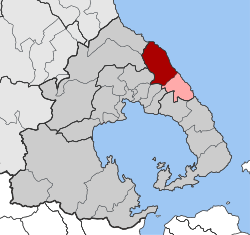Zagora, Greece
| Zagora Ζαγορά | |
|---|---|
 Zagora Location within the regional unit  | |
| Coordinates: 39°27′N 23°6′E / 39.450°N 23.100°ECoordinates: 39°27′N 23°6′E / 39.450°N 23.100°E | |
| Country | Greece |
| Administrative region | Thessaly |
| Regional unit | Magnesia |
| Municipality | Zagora-Mouresi |
| • Municipal unit | 96.1 km2 (37.1 sq mi) |
| Elevation | 458 m (1,503 ft) |
| Population (2011)[1] | |
| • Municipal unit | 3,334 |
| • Municipal unit density | 35/km2 (90/sq mi) |
| Community[1] | |
| • Population | 2,251 (2011) |
| Time zone | UTC+2 (EET) |
| • Summer (DST) | UTC+3 (EEST) |
| Postal code | 370 01 |
| Area code(s) | 24260 |
| Vehicle registration | ΒΟ |
Zagora (Greek: Ζαγορά) is a village and a former municipality in Magnesia, Thessaly, Greece. Since the 2011 local government reform it is part of the municipality Zagora-Mouresi, of which it is the seat and a municipal unit.[2] The municipal unit has an area of 96.101 km2.[3]
Location
Zagora is located north of Volos and west of Chorefto and is connected to the former by Greek National Road 34.
History
During the course of the 8th century, mainland Greece was subjected to numerous Bulgarian raids. At the end of the century, a large scale Bulgarian military expedition headed by the chieftain Akamir was launched from Belasica. The Bulgarians plundered Thessaly, from their encampment which was located between modern day Volos and Velestino. The Byzantines called those Bulgarians Velegizitas or Vielesti. According to Kordatos, Volos, Velestino, Zagora and many other placenames in Magnesia originate from that period and are of Slavic origin. The name Zagora comes from the Slavic term Zagorije which means, behind the mountains. First mentions of the settlement under its current name come from the 13th century. In the 14th century Magnesia came under the control of Serbia, subsequent conquests by the Republic of Venice and the Catalans led to a big drop in the local population.[4]
Places of interest
The library of Zagora, is known for its collection of rare books. The school of Rigas Feraios or Hellenic Museum as it is known, is the oldest school on Pelion. Rigas Feraios was among its students.
Education and commercial activity
Zagora has a primary and a secondary school, five churches, six coffee houses, two bakeries, two banks, a post office, and seven squares.
Historical population
| Year | Town population | Municipality population |
|---|---|---|
| 1981 | 2,841 | - |
| 1991 | 2,410 | 3,922 |
| 2001 | 2,389 | 3,829 |
| 2011 | 2,251 | 3,334 |
Notable people
- Patriarch Callinicus IV of Constantinople
- Yannis Kordatos, scholar
- Alexandros Pantos, founder of Panteion University
Footnotes
- 1 2 "Απογραφή Πληθυσμού - Κατοικιών 2011. ΜΟΝΙΜΟΣ Πληθυσμός" (in Greek). Hellenic Statistical Authority.
- ↑ Kallikratis law Greece Ministry of Interior (in Greek)
- ↑ "Population & housing census 2001 (incl. area and average elevation)" (PDF) (in Greek). National Statistical Service of Greece.
- ↑ Kordatos 1977, pp. 27–29.
References
- Kordatos, Ioannis (1977). Η Επανάσταση στην Θεσσαλομαγνησία το 1821 [The Revolt in Thessalomagnesia in 1821] (in Greek). Athens: Epikairotita.